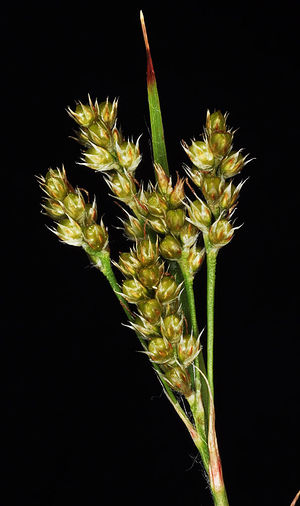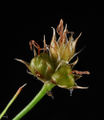Difference between revisions of "Luzula comosa var. laxa"
(→Taxonomy) |
m (→Referenecs) (Tag: VisualEditor) |
||
| Line 30: | Line 30: | ||
Inflorescence consists of 1 to 6 brownish glomerules (a condensed, headlike, cluster of flowers). The individual flowers consist of 6 membranous pallid, brownish tepals. ''Luzula comosa'' var. ''laxa'' generally has a more open, subumbellate inflorescence than ''Luzula comosa'' var. ''comosa'', which has a tighter capitate inflorescence. | Inflorescence consists of 1 to 6 brownish glomerules (a condensed, headlike, cluster of flowers). The individual flowers consist of 6 membranous pallid, brownish tepals. ''Luzula comosa'' var. ''laxa'' generally has a more open, subumbellate inflorescence than ''Luzula comosa'' var. ''comosa'', which has a tighter capitate inflorescence. | ||
| − | Juncaceae family members are differentiated from grasses in that they typically feature round stems, without nodes. <ref name=":0">Bowcutt, F., & Hamman, Sarah. (2016). ''Vascular plants | + | Juncaceae family members are differentiated from grasses in that they typically feature round stems, without nodes. <ref name=":0">Bowcutt, F., & Hamman, Sarah. (2016). ''Vascular plants'' |
| − | of the South Sound prairies'' (First ed.). Olympia, Washington: The Evergreen | + | of the South Sound prairies'' (First ed.). Olympia, Washington: The Evergreen'' |
State College Press.</ref><ref name=":1">Hitchcock, C. L., Cronquist, A., Giblin, D., & Legler, | State College Press.</ref><ref name=":1">Hitchcock, C. L., Cronquist, A., Giblin, D., & Legler, | ||
B. et al. (2018). ''Flora of the Pacific Northwest: an illustrated manual''. | B. et al. (2018). ''Flora of the Pacific Northwest: an illustrated manual''. | ||
| Line 65: | Line 65: | ||
== Photo Gallery == | == Photo Gallery == | ||
| + | <gallery> | ||
| + | File:LUZCOM2.jpg| Photo by Robert L. Carr | ||
| + | </gallery> | ||
| − | == | + | ==References== |
| − | + | ||
<references /> | <references /> | ||
Revision as of 17:07, 16 January 2021
- Latin Name: Luzula comosa var. laxa
- Family: Juncaceae
- Common Names: Pacific woodrush
- Synonyms/Misapplications: Luzula intermedia, Luzula multiflora subsp. comosa
- Codon: LUZCOM
Contents
Taxonomy
| Luzula comosa var. laxa | |
|---|---|

| |
| Photo by Robert L. Carr. Also featured on Main Page. | |
| Scientific classification | |
| Kingdom: | Plantae |
| Subkingdom: | Tracheobionta |
| Phylum: | Spermatophyta |
| Subphylum: | Magnoliophyta |
| Class: | Magnoliopsida |
| Subclass: | Lilianae |
| Order: | Poales |
| Family: | Juncaceae |
| Genus: | Luzula DC. |
| Species: | Luzula comosa E. Mey |
| Subspecies: | Luzula comosa var. laxa Buch. |
Description
Native tufted perennial, reaching 1-4 dm in height.
Leaves are grass-like, reddish to green, with long, fine hairs along leaf margin.
Inflorescence consists of 1 to 6 brownish glomerules (a condensed, headlike, cluster of flowers). The individual flowers consist of 6 membranous pallid, brownish tepals. Luzula comosa var. laxa generally has a more open, subumbellate inflorescence than Luzula comosa var. comosa, which has a tighter capitate inflorescence.
Juncaceae family members are differentiated from grasses in that they typically feature round stems, without nodes. [1][2]
Bloom Period
April to July[1]
Distribution
BC to California, along both sides of Cascades, east to Alberta, Montana, Utah, and New Mexico.[2]
Habitat
Openings, rocky slopes, forest, and shores, coastal to montane.[2]
Seed
Seed sample from: 2008
Average Measurement: 1.5 x 0.9 x 0.9
Measurement Range: L: 1.2 – 1.8, W: 0.8 – 1, D:0.8 – 1
Features
Shape: Seeds have prominent white caruncle. Seed mostly round except for a slightly pointed tapering at hilum and opposite apex.
Color: Seed coat is white over a dark reddish brown seed body.
Surface: On one side of seed there is a cloudy white line that crosses from hilum to opposite apex. Seed is lustrous and marked with many fine longitudinal lines.
Latitudinal Cross Section: elliptical 
Longitudinal Cross Section: elliptical ![]()
Photo Gallery
References
- ↑ 1.0 1.1 Bowcutt, F., & Hamman, Sarah. (2016). Vascular plants of the South Sound prairies (First ed.). Olympia, Washington: The Evergreen State College Press.
- ↑ 2.0 2.1 2.2 Hitchcock, C. L., Cronquist, A., Giblin, D., & Legler, B. et al. (2018). Flora of the Pacific Northwest: an illustrated manual. Seattle: University of Washington Press.

